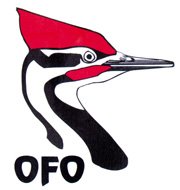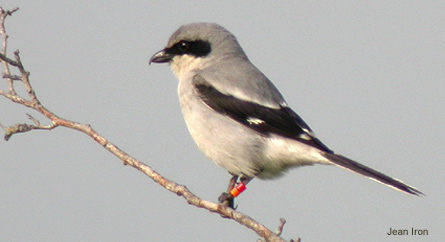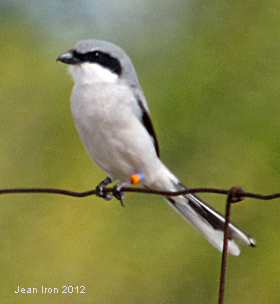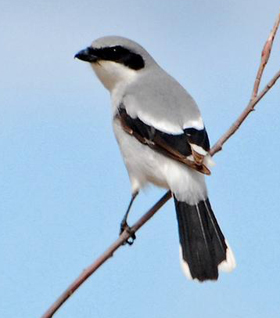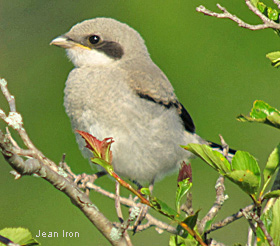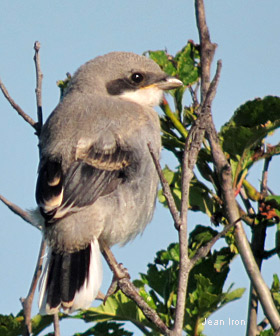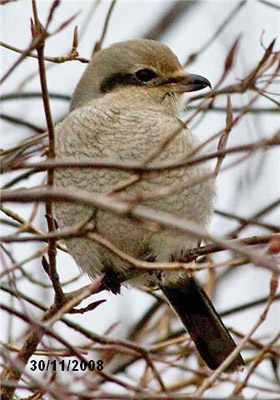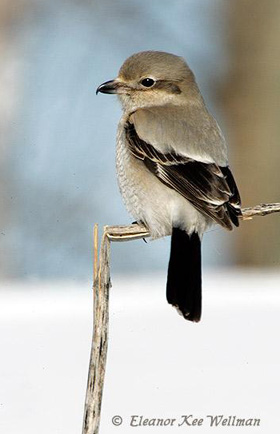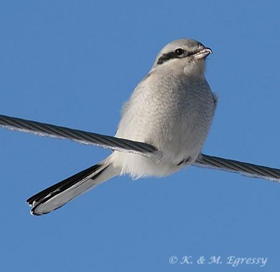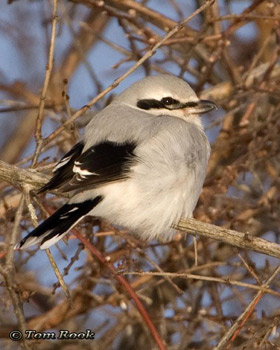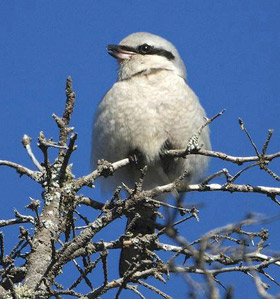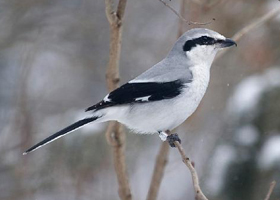by Ron Pittaway and Michael King
Revised February 2014. First published in OFO News 17(1): 6-7. February 1999.
Field guides make shrike identification seem much easier than it is. Most field marks used to separate adult Loggerhead and Northern Shrikes show variation and overlap. We do not discuss the identification of first year Northern Shrikes because they are easily identified by their brownish coloration, heavy barring below and lack of a face patch between the eye and bill. We include a section on aging Loggerhead Shrikes at a distance in summer which should be useful to those monitoring populations on the breeding grounds.
Status
The Loggerhead Shrike is endangered and declining in southern Ontario with very few breeding pairs in recent years. A few Loggerheads return in late March, but most arrive in mid-April. Most Loggerheads depart the province by late September; later birds should be identified with caution. The Northern Shrike breeds around Hudson and James Bays in northern Ontario. It is a scarce to uncommon winter visitor to southern Ontario. The first Northerns arrive south in early October and the last ones linger to late April. Use extreme caution identifying a shrike in March and April when both species may be present in southern Ontario.
Pitfalls
Northern Shrikes are most often misidentified as Loggerhead Shrikes in spring, especially March and April. Why? (1) Northerns lose much of the barring on their underparts by wear and appear clear breasted, (2) the Northern‘s bill becomes all dark in spring and (3) Northerns in spring act like Loggerheads by perching lower to hunt emerging worms, insects and frogs. For an identification challenge, in the illustration below compare the Loggerhead (middle left) and spring Northern (illustration below - middle right). Also compare the Loggerhead in photo 1 with the Northern in photo 10.
Underparts
Fall Loggerheads may show faint barring on the breast at close range, whereas fall and early winter Northerns are distinctly vermiculated below (illustration below - top right, and photos 5, 6, and 7). However, Northerns in spring often appear clear breasted because the vermiculations have worn off (illustration - middle right, and photos 8, 9 and 10). Therefore, a distinctly barred shrike in fall and early winter is a Northern, but the lack of barring on a late winter or spring shrike is inconclusive for Loggerhead.
Black Mask
In Loggerheads the black mask usually extends narrowly above the bill (illustration below - left head, and photos1 and 2), whereas most Northerns have no black there (illustration - right head and Photos 8 and 10). However, Godfrey (1986) cautioned that most Northerns, but not all, lack any black on the forehead. As well, Zimmerman (1955) “examined one Loggerhead Shrike that showed whitish feathers at the base of the culmen.” At close range, a typical Northern face on shows a narrow whitish arch over the base of the bill (illustration - right head, and photo 8). Another helpful mark, Northerns (absent in Loggerheads) usually have a small white area below the eyes, sometimes joined to the gray lores (illustration - right head and top right bird, and photos 7, 8 and 10).
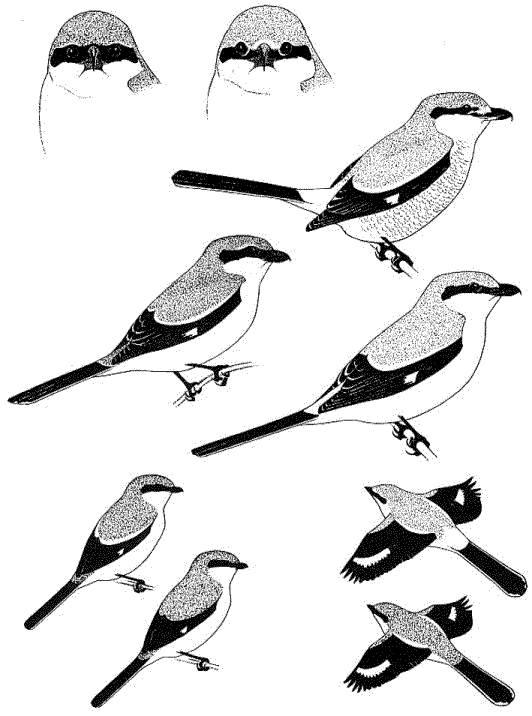
Top Heads: Loggerhead Shrike (left) and Northern Shrike (right)
Middle Three Large Birds: adult Loggerhead (middle left), fresh fall adult Northern (top right) and worn spring adult
Northern (middle right)
Bottom Two Perched Birds: adult Loggerhead (left) and juvenile Loggerhead (right), Two Flying
Birds: Northern (upper) and Loggerhead (lower). Drawing by Michael King
Bill Colour
Loggerheads have a pale base to the bill in fall, usually much smaller than in Northerns and confined to the lower mandible (Zimmerman 1955). However, a pale base to the lower mandible has not been reported for Loggerheads in Ontario (James 1983). In fall and early winter Northerns (illustration - top right, and photos 5 to 9), the pale base of the bill is extensive (one-quarter to one-third), often extending onto the upper mandible. Caution: Both species have entirely black bills in spring, sometimes as early as mid-March in Northerns (Zimmerman 1955).
Bill Size and Hook Size
Both species have hooked bills, but in most Northerns the hook is proportionately longer. Most Loggerheads have stubbier bills with a smaller hook. With practice it is possible to identify some Northerns by their longer, heavier and more strongly hooked bills. It is not unusual to see a shrike whose bill appears intermediate.
Rump Colour
Compare the two birds in flight. Most, but not all, Northerns have a contrasting white rump, noticeable in flight; it sometimes shows on perched birds. Ontario Loggerheads usually have gray rumps, showing little contrast with the back and tail. The western subspecies Lanius ludovicianus excubitorides (a possible vagrant to Ontario) of the Loggerhead Shrike has a whiter rump, more like a Northern, than eastern L. l. migrans. Rump colour is not diagnostic, but strongly suggests either Loggerhead (gray) or Northern (white) in Ontario.
Behaviour
Northern Shrikes typically perch near the top of a tall tree and fly higher than Loggerheads, usually maintaining level and slightly undulating flight between perches. Upon perching, Northerns repeatedly flick their tails upwards (James 1983). Loggerhead Shrikes rarely perch higher than 10 metres, usually lower on a shrub or mullein stalk. Taking flight, Loggerheads drop low, speeding along the ground, swooping upward to perch again. In many hours of watching Loggerheads, we rarely noted vigorous upward tail flicking. Usually after perching, a Loggerhead will tilt or wag its tail downwards in a deliberate motion reminiscent of an Eastern Phoebe. Northerns may move their tails downwards when balancing or in a wind, but they normally energetically flick their tails upwards. The different behaviours described above are not diagnostic, but suggest either Loggerhead or Northern Shrike.
Sexing and Aging
The sexes of both species are alike in all plumages. Juvenile Loggerhead Shrikes at close range (photos 3 and 4) are grayer overall than adults with fine barring on the underparts (except the throat), a more contrasting whitish throat and a somewhat duller mask stripe. At a distance, adult and juvenile Loggerheads appear very similar as shown by the two small perched birds at the bottom left. Adults (illustration - left bird, and photo 2) usually show a conspicuous wedge of white feathers, sometimes hidden, between the black wings and gray back. This mark is formed by the white tips of the outer scapulars and can be seen at a long range. Juveniles (illustration - right bird, and photo 4) lack the white scapular edges. Loggerheads retain juvenal plumage for only a few weeks in summer before molting into an adultlike plumage. Adult Northern Shrikes (photo 10) also show white scapular edges. Brownish first year Northerns become adult-like by spring.
AcknowledgementsTop
We thank Michel Gosselin of the Canadian Museum of Nature, Jean Iron, Mike Turner and Ron Tozer for helpful comments. Brad Millen kindly allowed access to study skins at the Royal Ontario Museum. Zimmerman (1955) and James (1983) referenced below are essential reading on shrike identification.
Literature CitedTop
1986. The Birds of Canada. Revised Edition. National Museums of Canada, Ottawa.
1983. Field identification of shrikes. Ontario Birds 1(1):18-21.
1955. Notes on shrike identification and comparative behaviour of shrikes in winter. Wilson Bulletin 67(3): 200-208.
